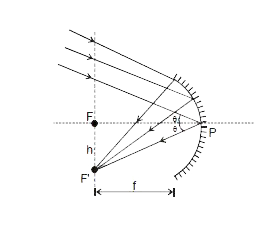STATEMENT-1 Law of reflection is applicable for all type of mirrors.
STATEMENT2Rays which are parallel to principal axis are known as paraxial rays.
STATEMENT -1is true statement 2 is true,Statement -2is a correct explanation for statement -1
STATEMENT -1is true statement 2 is true,Statement -2is a not a correct explanation for statement -1
Statement -1is true,Statement -2is False
Statement -1is False ,Statement -2is True
The correct Answer is:C
Rays whichare near and parallel to principal axis are known as paraxial axis.
Similar Questions
Knowledge Check
- Question 1 - Select One

Rays parallel to principal axis, incident on the spherical mirror at different heights from principal axis are focused at different points. And due to this reason we cannot define unique focus. This is known as spherical aberration. Angle of incidence θ shown in figure depends on the height of ray above principal axis. Focal length of spherical mirror can be easily written in terms of angle θ shown in figure as follows :
f=R−R2secθ
Here R is radius of curvature of mirror. The light rays which are very close to principal axis are known as paraxial rays and rays far away from principal axis are called marginal rays.
Let fP and fm represent the focal length corresponding to paraxial rays and marginal rays respectively thenALet fp and fm represent the focal length corresponding to paraxial rays and marginal rays respectively thenBfp=fmCfp>fmDfp<fm - Question 2 - Select One

Rays parallel to principal axis, incident on the spherical mirror at different heights from principal axis are focused at different points. And due to this reason we cannot define unique focus. This is known as spherical aberration. Angle of incidence θ shown in figure depends on the height of ray above principal axis. Focal length of spherical mirror can be easily written in terms of angle θ shown in figure as follows :
f=R−R2secθ
Here R is radius of curvature of mirror. The light rays which are very close to principal axis are known as paraxial rays and rays far away from principal axis are called marginal rays.
For paraxial rays focal length is approximatelyAFor paraxial rays focal length is approximatelyB2RCR/2D4R - Question 3 - Select One

Rays parallel to principal axis, incident on the spherical mirror at different heights from principal axis are focused at different points. And due to this reason we cannot define unique focus. This is known as spherical aberration. Angle of incidence θ shown in figure depends on the height of ray above principal axis. Focal length of spherical mirror can be easily written in terms of angle θ shown in figure as follows :
f=R−R2secθ
Here R is radius of curvature of mirror. The light rays which are very close to principal axis are known as paraxial rays and rays far away from principal axis are called marginal rays.
What will be the focal length for ray which is incident at an angle 60∘?AWhat will be the focal length for ray which is incident at an angle 60∘ ?BRC2RDR/2
STATEMENT-1: Real images cannot be formed by reflection of light in a convex mirror.
STATEMENT-2: Parallel rays incident on a convex mirror must diverge after reflection.View SolutionIn reflection over a spherical mirror, ray parallel to principal axis,after reflection from mirror pass through ...A… . Here, A refers to
View SolutionA ray parallel to the principal axis after reflection from a concave mirror will pass through
View SolutionSTATEMENT -1 : If reflected or refracted ray diverge from a point, the image will be virtual.
and
STATEMENT - 2 : After reflection or refraction the refracted or reflected rays appear to meet at a point on principle axis. They do not actually meet at a point.View SolutionAfter reflecton, a light ray which is incident along the principal axis of a mirror,
View Solution


